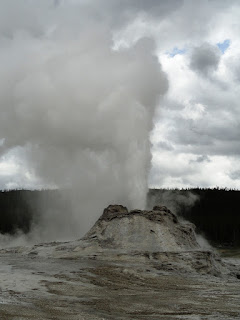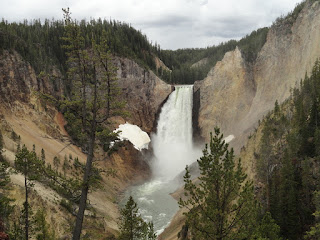Let's talk then about wild animals, with a variety apparently unparalleled in the US. The first picture shows deers and the second one, bisons - just in case you do not recognise them yourself... Ok, we got a big yellow leaflet saying that you should not approach the wildlife and keep a distance of 25 yards from bisons. But who knows what 25 yards are? Meters please! This was a close encounter. Yet the closest one was when we were in the car and literally surrounded by a huge herd of bisons. So many of them.
The animal that I was most keen to see was the bear. And we had to be committed to find one. Indeed the most direct road to the Lamar valley was closed - we could not drive through the entire 8 road, as a few roads are closed during the extended winter time time (yet, we were there at the end of May...!). The detour was worth it. First, we saw two baby grizzly hanging way up two different trees. I did not know bears were climbing trees so high up. An American tourist (who studied in Switzerland...) kindly offered us to look through his binoculars. Apparently, their mother had gone hunting, and the baby's best protection is to stay up in the trees. A few miles down the road, we got to see two black bears this time. The bigger one is pictured above. They were grazing...! So we can definitely say that Yellowstone is a great place to see bears.
Yellowstone was mostly created after a big volcano eruption. Of course, in the crater of the volcano, there should be a lake. This one is huge and peaceful - and more or less normal or even "boring". No trace of underground activity. Beautiful setting for a lunch picnic, with the snowy mountains in the background.
Indeed, other lakes, or rather basins, are more active, bubbling, "alive". Water heated up by the underground lava is coming to the surface. This happens in different ways. The first one is through wide openings - the temperature of the water can reach 70 degrees.
The second one, most spectacular, is through geysers. One called "Old Faithful" faithfully erupts according to a very predictable calendar. Tourists can then plan to sit and wait to see this geyser erupt. I was much more impressed by the one above - the castle geyser. I got lucky to see it, as its rythm is more erratic and infrequent. But there is was. The eruption lasted more than 20 minutes. It's difficult to image on the picture, but there is also a strong noise and the odor of rotten egg (because of the sulfur). So much so that my friend said one could fart unnoticed...
Another manifestation of the heat coming from below is the smoke/vapor. Driving through the park, time and again there is smoke coming out of the ground and raising above the trees.
A more gentle form is the hot springs. Apparently, in winter, animals come and sit in these ponds to warm up.
There are also spectacular waterfalls in the park, like the lower Yellowstone river falls. Notice the snow still on the left side of the falls.









Aucun commentaire:
Enregistrer un commentaire